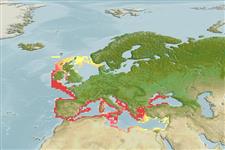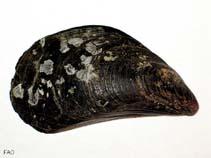Mytilus galloprovincialis Lamarck, 1819
Mediterranean mussel| Native range | All suitable habitat | Point map | Year 2050 |

|
| This map was computer-generated and has not yet been reviewed. |
| Mytilus galloprovincialis AquaMaps Data sources: GBIF OBIS |
Classification / Names Common names | Synonyms | CoL | ITIS | WoRMS
| Mytilida | Mytilidae
Environment: milieu / climate zone / depth range / distribution range Ecología
; rango de profundidad 125 - 200 m (Ref. 2754). Tropical, preferred 16°C (Ref. 107945); 61°N - 30°N, 11°W - 36°E
Distribución Países | Áreas FAO | Ecosistemas | Ocurrencias, apariciones | Introducciones
Northeast Atlantic, the Mediterranean and the Black Sea. Introduced to the Arctic, Indian and Pacific Oceans.
Length at first maturity / Tamaño / Peso / Age
Maturity: Lm ? range ? - ? cm Max length : 16.5 cm SHL macho / no sexado; (Ref. 109255)
Short description Morfología
The shell lacks radiating ridges containing three small teeth below the beak. The exterior is often bluish black with the interior portion being dull blue (Ref. 310).
Found in warmer waters (Ref. 95344). Occurs in quiet waters and lives lower in the intertidal zone attached to rock substrates (Refs. 310, 125090). Inhabits muddy and sandy bottoms (Ref. 125090). Smaller individuals move to the outer edge of the colony (Ref. 310). Feeds on a variety of phyto- and zooplankton (Ref. 112108).
Life cycle and mating behavior Madurez | Reproducción | Puesta | Huevos | Fecundidad | Larva
Members of the class Bivalvia are mostly gonochoric, some are protandric hermaphrodites. Life cycle: Embryos develop into free-swimming trocophore larvae, succeeded by the bivalve veliger, resembling a miniature clam.
Main reference
Referencias | Coordinador | Colaboradores
Demir, M. 2003. (Ref. 2754)
IUCN Red List Status (Ref. 130435)
CITES status (Ref. 108899)
Not Evaluated
CMS (Ref. 116361)
Not Evaluated
Threat to humans
Human uses
Pesquerías: comercial
FAO - Acuicultura: producción, species profile; pesquerías: landings, species profile | FishSource | Sea Around Us
Herramientas
Más información
Fuentes de Internet
BHL | BOLD Systems | CISTI | DiscoverLife | FAO(Acuicultura: species profile; pesquerías: species profile; publication : search) | Fishipedia | GenBank (genome, nucleotide) | GloBI | Gomexsi | Google Books | Google Scholar | Google | PubMed | Árbol de la vida | Wikipedia (Go, búsqueda) | Expediente Zoológico
Estimates based on models
Preferred temperature
(Ref. 115969): 5.5 - 18, mean 11 (based on 176 cells).
Resiliencia
(Ref. 69278):
Alto, población duplicada en un tiempo mínimo inferior a 15 meses (K=0.1-1.82).
Prior r = 0.50, 95% CL = 0.33 - 0.75, Based on 2 data-limited stock assessments.
Nutrients: Calcium = 149 [71, 228] mg/100g; Iron = 8.53 [1.95, 15.11] mg/100g; Protein = 9.88 [8.64, 11.12] %; Omega3 = 0.313 [0.202, 0.423] g/100g; Selenium = 61 [50, 72] μg/100g; VitaminA = 0 μg/100g; Zinc = 2.04 [0.56, 3.51] mg/100g (wet weight).



